Möchten Sie das Disqus-Kommentarsystem zu Ihrer WordPress-Website hinzufügen?
Disqus ist eine der beliebtesten Kommentarplattformen auf dem Markt. Sie ist bekannt für ihre benutzerfreundliche Oberfläche und ihren Kommentar-Hosting-Service, was sie zu einer ersten Wahl für beliebte Websites wie PBS und Bloomberg macht.
In dieser Anleitung werden wir darüber sprechen, ob Sie Disqus zu Ihrer Website hinzufügen sollten und wie Sie es in WordPress aktivieren.
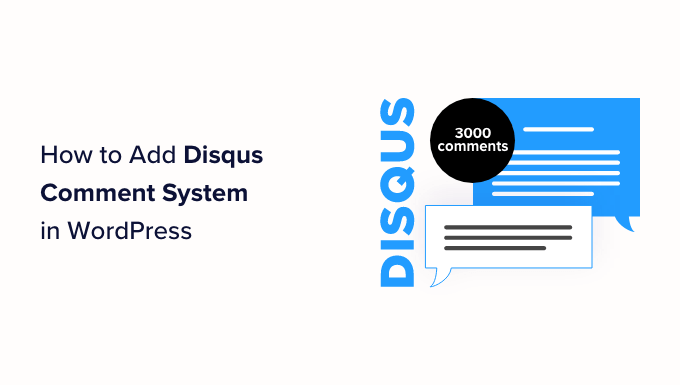
Sollten Sie Disqus mit WordPress verwenden?
Das Standard-Kommentarsystem von WordPress eignet sich zwar für einfache Kommentare, ist aber nicht das leistungsfähigste. Deshalb suchen viele WordPress-Nutzer nach Alternativen wie Disqus.
Das Disqus-Kommentarsystem ist bei großen Websites sehr beliebt. Abgesehen von seiner Benutzerfreundlichkeit und den Anpassungsmöglichkeiten bietet es auch eine Drittanbieter-Hosting-Plattform für die Speicherung und Verwaltung von Kommentaren.
Da Disqus die Kommentare auf einem von Ihrem WordPress-Hosting getrennten Server bearbeitet, kann die Verwendung von Disqus die Gesamtleistung Ihrer Website verbessern.
Unserer Meinung nach ist Disqus jedoch nicht das beste Kommentarsystem, das wir ausprobiert haben. Es hat uns zwar bei der Performance unserer Website geholfen, aber wir waren kein Fan seiner Moderationsfähigkeiten, und es fügte unseren Inhalten ohne unsere Erlaubnis Affiliate-Links hinzu.
Nach der Deaktivierung von Disqus konnten wir einen deutlichen Anstieg unserer Engagement-Rate feststellen. Sie können mehr über unsere Erfahrungen in unserem Disqus-Bericht lesen.
Ob Sie Disqus oder andere Plattformen verwenden, bleibt natürlich Ihnen überlassen. Aber wenn Sie auf der Suche nach Disqus-Alternativen sind, dann haben wir einige Empfehlungen.
Was man anstelle von Disqus verwenden kann
Nach dem Ausprobieren verschiedener Kommentar-Plugins haben wir festgestellt, dass Thrive Comments die beste Disqus-Alternative ist.
Thrive Comments ist ein All-in-One-Kommentar-Plugin mit einer einfach zu bedienenden Benutzeroberfläche, die sowohl für Blogging-Anfänger als auch für Experten geeignet ist.

Neben den Funktionen zur Verwaltung und Moderation von Kommentaren können Sie Thrive Comments nutzen, um das Engagement der Nutzer mit Post-Kommentar-Aktionen zu steigern. Nachdem der Nutzer einen Kommentar hinterlassen hat, können Sie ihn zu verwandten Beiträgen oder einer benutzerdefinierten Dankesnachricht mit einem kostenlosen Geschenk weiterleiten.
Außerdem können Sie „Likes“ und „Dislikes“ sowie „Upvotes“ und „Downvotes“ hinzufügen, um die Interaktion mit dem Publikum in Ihrem Kommentarbereich zu fördern.
Weitere Einzelheiten finden Sie in unserem Bericht über die Thrive Themes-Suite, der einen Abschnitt speziell über Thrive Comments enthält.
Wenn Thrive Comments nicht Ihren Anforderungen entspricht, dann können Sie auch unsere vollständige Liste der besten WordPress-Plugins zur Verbesserung von Kommentaren ansehen.
Wenn Sie immer noch an der Verwendung von Disqus interessiert sind, machen Sie sich keine Sorgen. Wir erklären Ihnen, wie Sie das Disqus-Kommentarsystem-Plugin hinzufügen können. Sie können die Quicklinks verwenden, um zu den einzelnen Abschnitten zu springen:
Einrichten des Disqus-Kommentarsystems in WordPress
Der erste Schritt zur Installation von Disqus-Kommentaren in WordPress besteht darin, ein Disqus-Konto zu erstellen. Dazu müssen Sie auf die Disqus-Website gehen und sich dort anmelden.
Sobald Sie das getan haben, sollten Sie die folgende Seite sehen. Klicken Sie einfach auf „Ich möchte Disqus auf meiner Website installieren“.
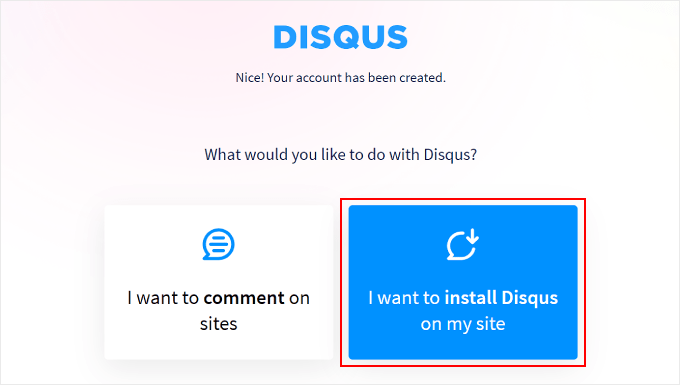
Auf der nächsten Seite müssen Sie die Details für Ihre neue Disqus-Website eingeben, auf der Sie alle Ihre Disqus-Kommentare verwalten werden. Dazu gehören Website-Eigentümer, Website-Name und Kategorie.
In das Feld Website-Name können Sie die gewünschte Disqus-Subdomain eingeben. Danach klicken Sie einfach auf „Website erstellen“.
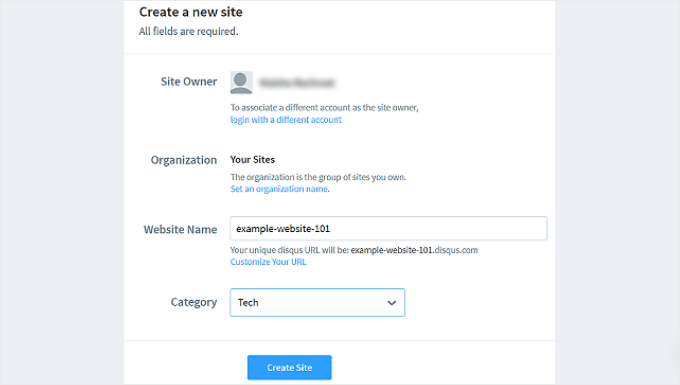
Sie gelangen nun auf das Dashboard der Disqus-Website.
An dieser Stelle müssen Sie sich für einen der Disqus-Pläne entscheiden, um das Kommentarsystem in WordPress einrichten zu können. Wenn Sie noch nicht sicher sind, welches Sie verwenden sollen, können Sie mit dem kostenlosen Basic-Plan beginnen.

Sie werden nun aufgefordert, eine Plattform zu wählen.
Wählen Sie einfach „WordPress“, um fortzufahren.
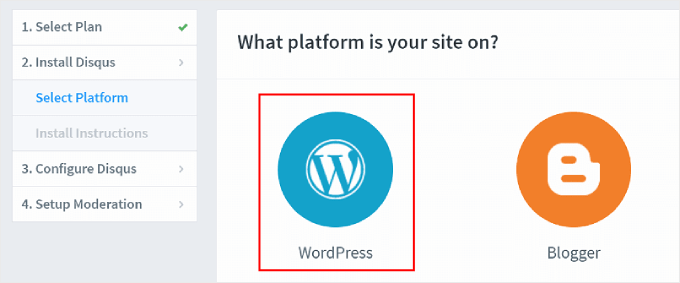
Sie sehen nun die WordPress-Installationsseite. Beachten Sie das Feld Installations-Token, das für die spätere Einrichtung nützlich sein wird.
Sie können diese Registerkarte geöffnet lassen, während Sie mit den nächsten Schritten fortfahren.
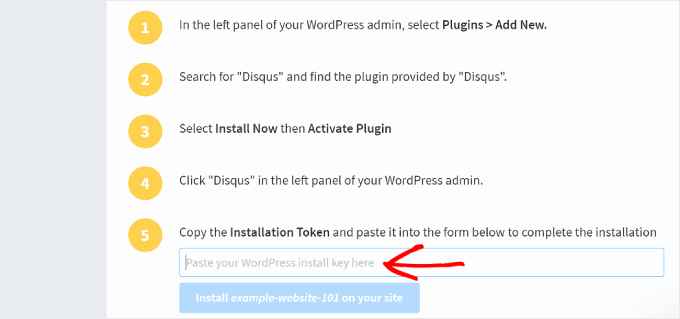
Öffnen Sie nun Ihr WordPress-Dashboard, um das Disqus Comment System Plugin zu installieren. Eine schrittweise Anleitung finden Sie in unserem Leitfaden zur Installation eines WordPress-Plugins.
Gehen Sie anschließend in Ihrem WordPress-Dashboard zum Disqus-Menü. Unter „Haben Sie ein Disqus-Konto?“ klicken Sie auf „Ja“.
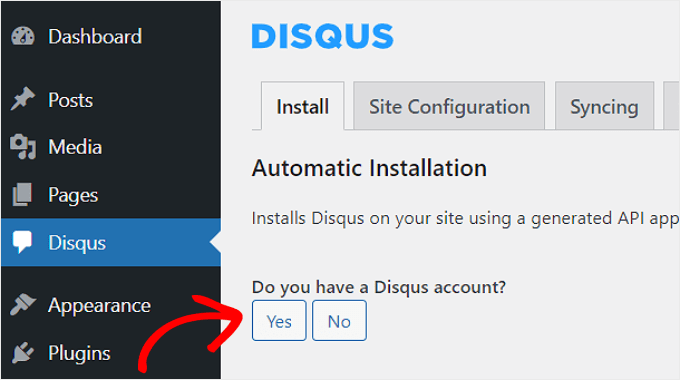
Sie werden nun die Frage sehen: „Haben Sie eine bei Disqus registrierte Website, die Sie nutzen möchten?
Wählen Sie „Ja“.
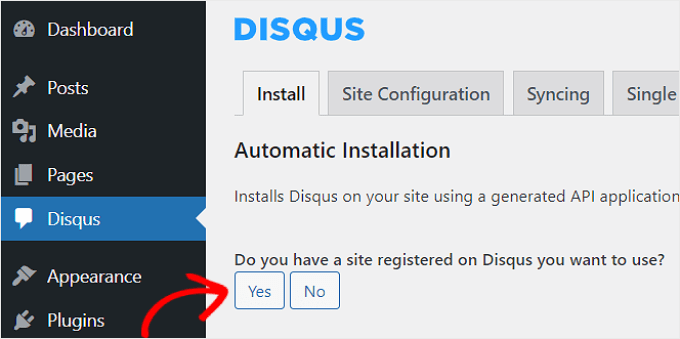
An dieser Stelle werden Ihnen einige WordPress-Installationsanweisungen und ein zu kopierendes Sync-Token angezeigt.
Klicken Sie hier auf die Schaltfläche „Kopieren“.
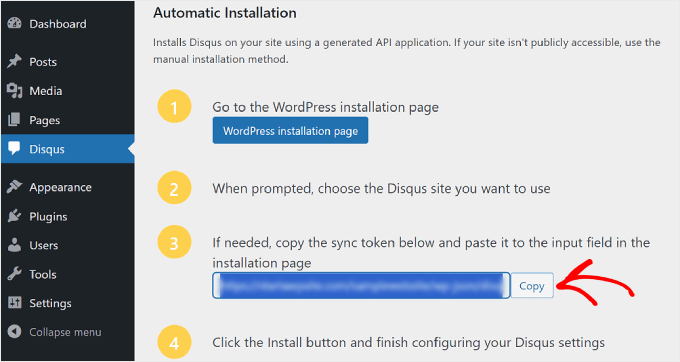
Kehren wir nun auf die Disqus-Website zurück. Fügen Sie den Token, den Sie gerade aus dem WordPress-Dashboard kopiert haben, in das entsprechende Feld ein.
Klicken Sie dann auf die Schaltfläche „Installieren Sie [Name der Disqus-Website] auf Ihrer Website“ und klicken Sie unten auf „Konfigurieren“.
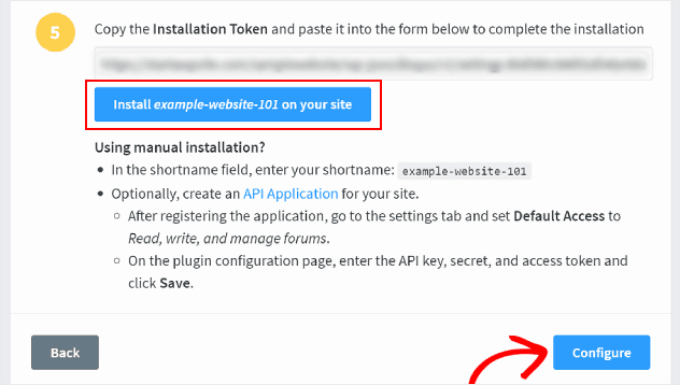
Und das war’s!
Wenn Sie das Disqus-Menü in Ihrem WordPress-Dashboard aktualisieren, sollten Sie nun eine ähnliche Oberfläche wie diese sehen:
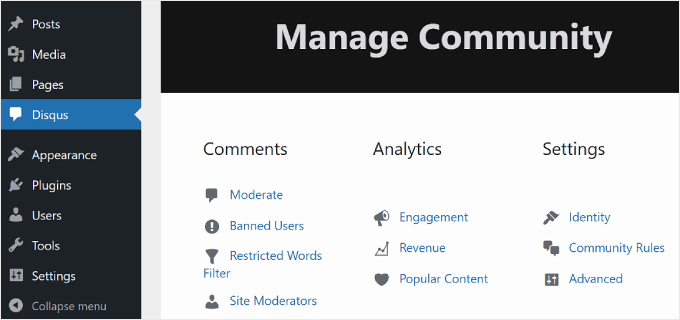
Nun wollen wir sehen, ob Disqus erfolgreich in Ihrem Kommentarbereich aktiviert wurde.
Öffnen Sie einfach einen WordPress-Blogbeitrag im Frontend und scrollen Sie bis zu den Kommentaren. So sollte es aussehen, wenn die Installation korrekt durchgeführt wurde:
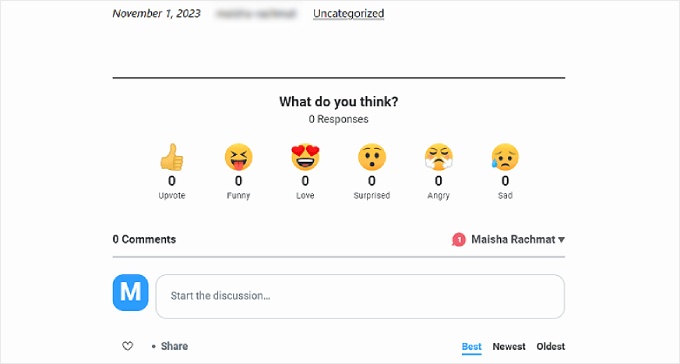
Exportieren älterer WordPress-Kommentare in Disqus
Sobald Sie das Disqus-Kommentarsystem installiert haben, wird es die nativen WordPress-Kommentare auf Ihrer Website übernehmen. Mit anderen Worten: Die auf Ihrer WordPress-Website gespeicherten Kommentare werden für die Nutzer nicht mehr sichtbar sein.
Um dies zu beheben, müssen Sie alle vorhandenen Kommentare in das Disqus-Kommentarsystem importieren. Gehen Sie im WordPress-Verwaltungsbereich auf die Einstellungsseite des Disqus-Plugins, scrollen Sie nach unten und navigieren Sie zur Registerkarte „Synchronisierung“.
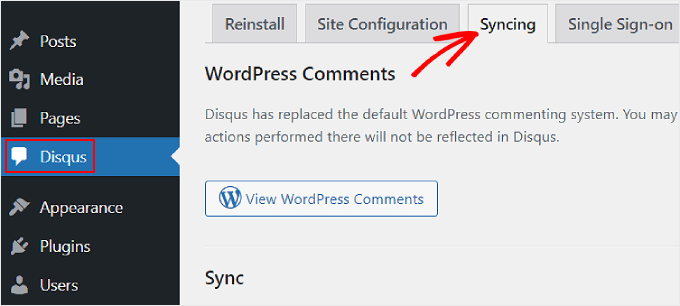
Scrollen Sie dann nach unten und wählen Sie „Kommentare importieren“.
In der Tabelle unten sehen Sie, welche Ihrer Kommentare erfolgreich importiert wurden.
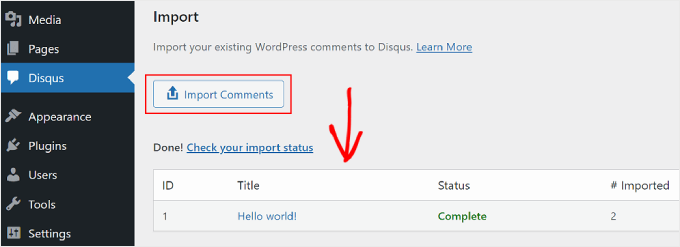
Wenn Sie benutzerdefinierte Beitragstypen verwenden, kann es sein, dass Ihre älteren Kommentare nach der Umstellung auf Disqus nicht mehr angezeigt werden. Um dies zu beheben, müssen Sie Disqus für benutzerdefinierte Beitragstypen deaktivieren.
Eine praktische Anleitung finden Sie in unserem Artikel über die Deaktivierung von Disqus in benutzerdefinierten Beitragstypen.
Disqus-Kommentare moderieren und konfigurieren
Wenn Sie Kommentare mit Disqus moderieren möchten, können Sie auf der Seite des Disqus-Plugins auf die Schaltfläche „Moderieren“ klicken.
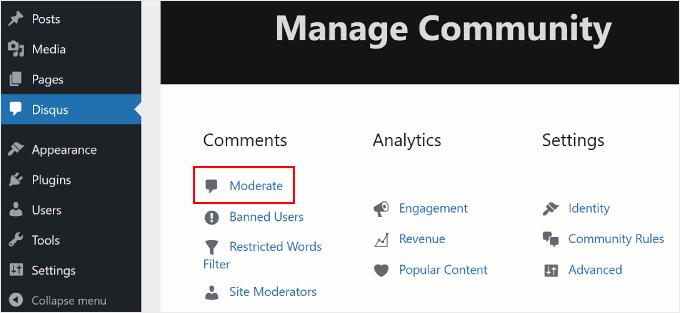
Dies bringt Sie zur Moderationsseite auf der Disqus-Website.
Wenn Sie mit der WordPress-Kommentarseite vertraut sind, wird die Navigation auf der Disqus-Seite kein Problem sein. Hier können Sie Kommentare genehmigen, löschen oder als Spam markieren.
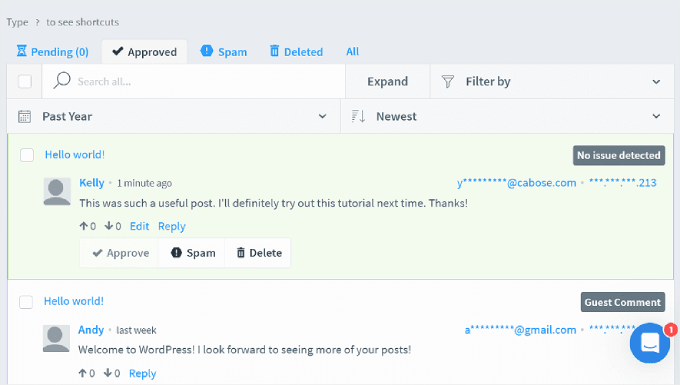
Tipps und Tricks zur WordPress-Kommentarmoderation finden Sie in den folgenden Artikeln:
- Anleitung für Anfänger zum Moderieren von Kommentaren in WordPress
- Wie man Blog-Benutzern erlaubt, Kommentare in WordPress zu moderieren
- So erlauben Sie Benutzern, ihre Kommentare in WordPress zu bearbeiten
Fehlerbehebung bei der Anzeige von Disqus-Kommentaren
Bei einigen WordPress-Themes kann der Disqus-Kommentarbereich breiter als der Rest des Beitragsbereichs erscheinen. Um dies zu beheben, müssen Sie einige benutzerdefinierte CSS in das Stylesheet Ihres Themes oder Child-Themes einfügen.
Sie können zwar benutzerdefinierte CSS über den Editor der Themadatei hinzufügen, aber wir empfehlen dies nicht. Die Nachverfolgung von Änderungen wird dadurch erschwert und es wird unklar, welcher Code aus dem Theme stammt und welcher benutzerdefiniert ist.
Stattdessen empfehlen wir die Verwendung von WPCode, dem einfachsten Code-Snippets-Plugin. Damit können Sie sicher benutzerdefinierten Code auf Ihrer WordPress-Website hinzufügen und verwalten. Wenn der Code nicht funktioniert, können Sie das Snippet innerhalb des Plugins einfach entfernen.
Den Code, den Sie hinzufügen müssen, finden Sie unten:
#disqus_thread {
margin: 0 auto;
max-width: 650px;
}
Dieses CSS setzt die maximale Breite des Kommentarbereichs auf 650px und zentriert ihn auf dem Bildschirm. Ihr Theme kann eine andere Breite haben, also müssen Sie es an Ihre Bedürfnisse anpassen.
Eine Schritt-für-Schritt-Anleitung finden Sie in unserem Leitfaden zum einfachen Hinzufügen von benutzerdefiniertem CSS zu Ihrer WordPress-Website.
So sollte es bei WPCode aussehen:
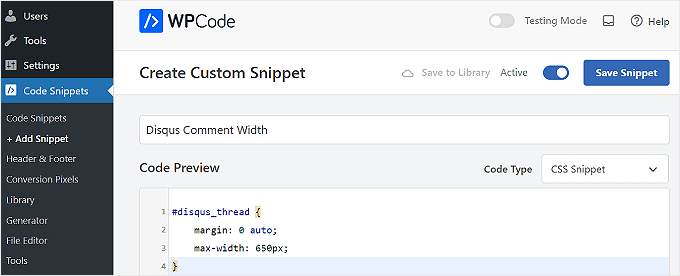
Und das war’s mit dem Hinzufügen von Disqus zu WordPress!
Wir hoffen, dass dieser Artikel Ihnen geholfen hat zu lernen, wie Sie das Disqus-Kommentarsystem in WordPress hinzufügen können. Vielleicht möchten Sie auch unseren Leitfaden zum Einfügen oder Begraben von Kommentaren in WordPress und unsere Expertenauswahl für die besten WordPress-Plugins zur Erweiterung Ihrer Website lesen.
Wenn Ihnen dieser Artikel gefallen hat, dann abonnieren Sie bitte unseren YouTube-Kanal für WordPress-Videotutorials. Sie können uns auch auf Twitter und Facebook finden.





Syed Balkhi says
Hey WPBeginner readers,
Did you know you can win exciting prizes by commenting on WPBeginner?
Every month, our top blog commenters will win HUGE rewards, including premium WordPress plugin licenses and cash prizes.
You can get more details about the contest from here.
Start sharing your thoughts below to stand a chance to win!
Nazmul Koushik says
Hi, Thank you So much for this tutorial .
WPBeginner Support says
Glad our guide was helpful
Admin
Danielle says
How would I go about making sure that my Disqus comments from my old Blogger site appear on my new WordPress site? I just used your setup service to transfer my content from Blogger to WordPress last month.
WPBeginner Support says
If your Disqus coments are not available then you would go into Disqus and export the old comments to import them to the new site.
Admin
Deepak jerry says
Thank You So Much For This Tutorial !
WPBeginner Support says
You’re welcome
Admin
Deepa says
Thanks for ur information
WPBeginner Support says
You’re welcome
Admin
David says
This information has helped me integrate disqus comment system to my personal website. Thank you so much.
WPBeginner Support says
Glad our article could help
Admin
Nihal Singh says
Thanks for the useful article to add the comments in WordPress. It is very useful.
WPBeginner Support says
Glad you found our content helpful
Admin
Irene Hynes says
Hi There,
Hip Hip Hooray! I was always told that slightly slow in the head, a slow learner. Not anymore! It’s like you have my back. I can’t tell you how much I’ve learnt here and how easily! Thank you for blessing me with this effortlessly ingestible digestible content.
I was wondering if it was possible assign to a variable type of Array of Strings a value from the REFramework Config file.
Thank you very much and will look for more postings from you.
Kind Regards,
Irene Hynes
John says
Is there any way to use both Disqus comment and WordPress comment together or separately?
Mike says
Hey Guys!
I am going to have my site
I intend to optimized my site and incresed the speed of loading page. which plugin do you suggest?
Thanks in advance
Mike
Hitesh Sharma says
I was looking for so long for this type of informative post on Discus. Thanks alot
Jagadish Prasad B says
Hello, I am Jagadish. I added Disqus comment system on my website, but it’s not working. What happen is by mistake I deleted the site from Disqus, before that it’s worked properly. After deletion, I re-added it into Disqus but it’s not working, I tried so many times. Please help me.
Agus Tamanuri says
Thanks
Because this article is help me .. and one more
I will make this blog name into the shirt. Is it allowed?
daniel says
Thanks!
Ahmad says
Thanks for ur information
Rachael Portier says
Every time I log into Disqus through WordPress it keeps telling me „Unable to connect to the Disqus API servers“. I’m sure my email and password are correct though. Please help!
ide says
i have same problem,
chukwudi ojukwu says
thanks for the info. i just install disqus on my site with your guide.
Scott Johnson says
Good article, but I am wondering why this current post is not setup with the Disqus plugin? Change of heart?
Dwayne says
Thanks for this post. Just implemented it though i’m yet get the confirmation email from them after creating the account more than 12 hrs ago. Oddly i got an email after setting it up on my wordpress site but yet to get the confirmation email.
Biju says
I’m really glad to meet your blog. Finally I’ve found my solution for WP site… Thanks again.
Antony says
Hey,
Thanks for the Post – Just now Set Up Disqus on my Website! D
GroomingMail says
Hey, quick question. I have just installed Disqus and previously had a spam filter (WP-SpamShield) can i now remove the filter as Disqus has its own spam filter or should i keep the WP-SpamShield plugin?
Thanks,
WPBeginner Support says
Yes you can.
Admin
Theo Ramlall says
As always, another well written article from wpbeginner.com
I started of seeking help with my problem, which was the size of the over lapping comment bar but grateful your CS hack above did fix it. However I would be overjoyed in having a comment system exactly like this….if you could provide some know-how..?
Best Regards
Theo
Aishwarya says
Hey,
By default, Disqus appears on your posts, not pages. In case you are looking to add Disqus to a particular page on your wordpress website, you can try this simple hack I used.
Just plugin the universal code at the end of your page in WordPress’s text editor. It works well for me,
mukekaton says
Disqus not appear on wordpress page. Only in post appear. How do I make disqus appear on page?
Arbin says
Which is that universal code? bc to me doesn’t show also in posts.
Aaron Jane says
Hello,
I’m getting lot of spams on my site with the default comment system, though I have akismet installed. Thought about using Disqus, but I see that Disqus is no longer used by wpbeginner. Can you share why you moved away from disqus ?
Thanks Aaron.
WPBeginner Support says
Here is why we switched away from Disqus.
Admin
Theo says
Thanks a whole lot for this post. I’ve decided to start using disqus for some of the same reasons you mentioned here. This was helpful!
Mohammed Haseeb says
Okay. I know Disqus is good but I have a question. Is there a way to remove hyperlinks from profile names of people commenting on my blog posts. Here is the link to my blog
AlleXyS says
Hello … I tried some days to activate disqus on my website. CAN’T , due of a issue in database…. I install disqus (plugin) => comments => disqus => tell me to upgrade my DATABASE !! I click UPGRADE, but nothing happening, my website tell me that this page can’t be found .. So, I think the script can’t run
here I can’t arrive : http://cdn2.wpbeginner.com/wp-content/uploads/2014/04/disqus-signin.png
WPBeginner Support says
Please contact Disqus support they would be better able to help you with that.
Admin
WPBeginner Staff says
Disqus.
Adjie Al-Faruq says
how to fix „unable to connect to the disqus api servers“
Bora M. Deniz says
Hi, very simple expression and useful article. I’m between jetpack plugin and disqus system .Which one is the more useful for visitors and further SEO of website ?
Santhosh Veer says
when i try to import the worpdress comments i show error please help me to fix this
Andreia Franco says
I have disqus on my blog for a couple of months, since then I just have received lots of spams and disqus doesn’t work at all. I see disqus on other wordpress blogs and it seem to work very well. I do not know what to do with mine. I always go back to moderate and try to activate it but it doesn’t work, still. Do you have any suggestions?
couture31 says
SOOO glad to have you all as a resource! I have transitioned to a self-hosted WP site and I visit your site daily for tips! Thanks for your help and patience…the step by step directions are awesome!! So grateful!
WPBeginner Staff says
Edit the post and make sure comments are enabled for that post. Also go to Settings > Discussion and make sure that the box next to ‚Automatically close comments on articles older __ days‘ is unchecked.
UgochukwuEmmanuelAgbams says
Thanks for this tutorial. I have earlier registered on disqus, installed and activated the plugin, but ny problem now is, at the footer of my blog post after disqus, I have a report that says, ‚comments are closed‘, and another issue is, disqus does not sync with my loged in users. What should I do about this?
Kerryvaaine says
It is available as a plugin in wordpress.
Neal Umphred says
My experience trying to get Disqus onto my site does not resemble anything like what you have written above. It’s an hour later and I can’t get anything happening . . .
Teresa Robeson says
I sympathize because it is the same for me. There is no „plugins“ link on my admin page, nor is there any option for adding Disqus (or anything else) under the Comments link. Maybe it’s because I’ve only got a free WP site, but I didn’t have this much trouble installing Disqus on my Blogger site. There are days I really hate WordPress.
I hope you got it figured out since you posted 2 weeks ago.
Dennis says
I personally have used jetpack comments for comment on site to handle spam. Most persons I have noticed are usually uncommon with the disqus concepts and dislike the sign up process, very few notice the ‚guest‘ option. But I’m looking into using Vanilla comments by integrating vanilla forums into my wordpress website and keep the comment actions completely under my control simples like a good option to me so far from testing.
Aaron Aarons says
I don’t have my own blog but I regularly post comments to blogs that use Disqus. Quite frankly, there is so much I dislike about Disqus that I would never use it, without major future improvements, in a blog I had any control over.
1) Comments either don’t show up at all in Google searches on phrases within them, or they show up as part of the page of the particular commenter’s Disqus comments, rather than as part of the page they comment on.
2) If I save a web page that has Disqus comments, the comments are not saved with the page, and the ability to retrieve the comments depends on the future maintenance of such comment threads by Disqus.
3) I can save a page with comments as a PDF, but then the information about the precise date and time of a comment can no longer be seen even by a mouse-over (nor by looking at the non-existent source), so all one sees is how many days, weeks, months or years before the time the page was saved the comment was posted. This makes it impossible to follow the chronology of a discussion.
4) In one case, a blogger lost his domain name and had to get a new, different one. Since then, the old pages can be accessed with the new domain name, but the old comments do not show. There is a way to get to the original comment thread, but it’s not accessible to the casual user.
There are other, less serious, annoyances, that have slipped my mind for the moment.
If I am wrong about any of the items I had listed as problems above, I’d like to know.
Earl Henson says
I wonder if Google traffic is lower than it would be if comments don’t show in Google? And of course comments would be the same with Disqus but wouldn’t they become higher over time as more people discover this blog? But if NEW users can’t discover this blog because the comments are not Google searchable…..
Codex73 says
Recently installed „Disqus Comment System“ WordPress plugin, it displays correctly and accepts comments. When I reply through the Dashboard, these won’t show on thread. Should replies be handled directly in the Disqus thread instead?
Bricky says
Is there a way to display a number in front of each comment using disqus?
Metal Mofos says
What about SEO?
Dave says
Even with Disqus, the comments are fully indexed along with the page. Do a View Source of this page to see for yourself.
Rob Orr says
That’s not necessarily true. It’s possible that Google will index your comments, but I’ve seen many more that are not indexed as opposed to those that are.
WPBeginner Staff says
We wrote about this plugin in our guide on how to add Google+ comments in WordPress.
Animish says
Thanks for this useful article. But there is one question stuck in my mind. Does Disqus affect the load time of posts? Because it uses iframe to load comments. Didi you notice any difference?
Jeanz says
Hello Syed. What you think about this plugin? – WordPress Comments Evolved – that allow to display G+ comments, FB comments, WordPress and Disqus. I can’t find any useful review in google search, thanks
Mehmet Fatih Yorulmaz says
I have two problems about Disqus (which I already use):
First, it does not allow me to convert my commenters to subscribers by adding a checkbox to the bottom of the comment box. Normally, I was using Mailchimp Comment Optin plugin for this. Also, it does not work with „Comment Redirect by Yoast“ plugin…
Second problem is, Subscribe button is difficult to notice for inexperienced commenters. In wordpress comment box, the simple checkbox for subscribing to the replies was very easy to notice. Also, guest commenters are by default subscribed to all comments. And they are not given option to subscribe to „only replies“. Last, but not least, the word „subscribe“ is very ambigious. What is it? Subscribe to my site, subscribe to my newsletter or subscribe to the comments?…
Third issue is, language support. My site is in Turkish and I can select Disqus interface to be in Turkish. But, when my not English speaking visitor hits „Subscribe“, they are sent an English confirmation email. Or when they wanna edit their subscription preferences, again they are being forwarded to an all Engish page.
I appreciate your thoughts on these issues…
Thanks
WPBeginner Staff says
Manuel, we haven’t noticed any decline in the number of comments we receive on WPBeginner.
Manuel Echeverry says
its true but there a some WP pages that claim that have to disable disqus because the visitors dint like it. I personaly use Disqus in my site and have no bat experiences until now, but its something that we have to pay attention
Manuel Echeverry says
I love disqus but the are some people that claim is hard to use por the blog visitors making you lose commenters, wath do you know about that
WPBeginner Staff says
No actually the number of comments is nearly the same as before. There is less spam though.
Gagan Masoun says
Now, you are also getting too many comments after adding Disqus comment system…